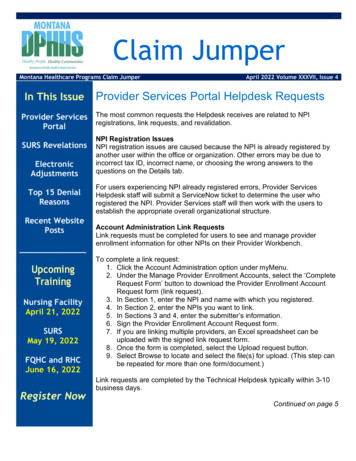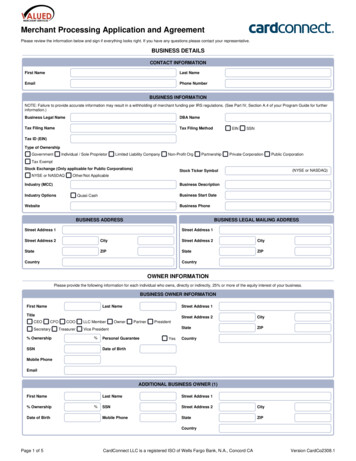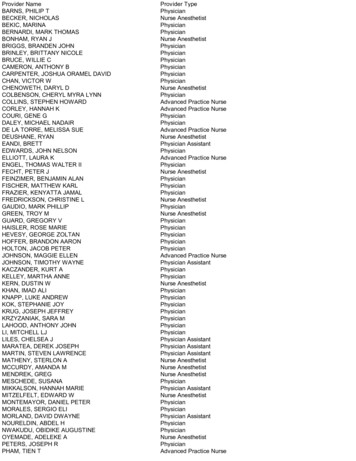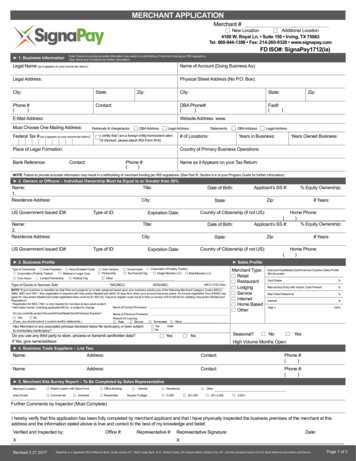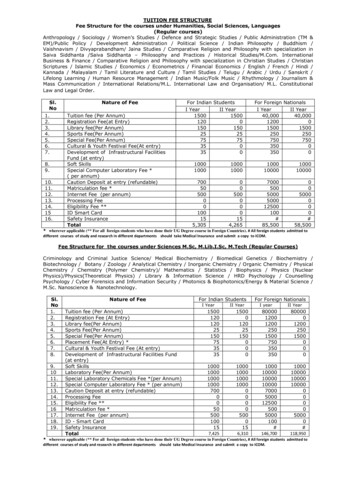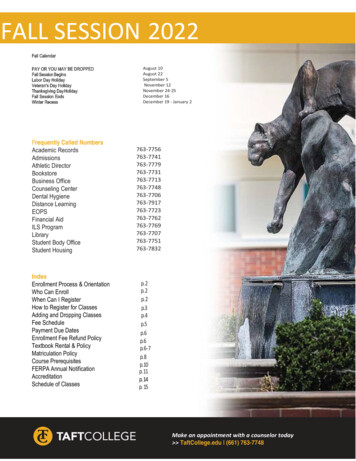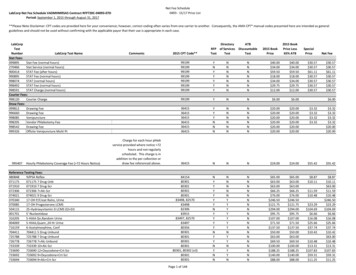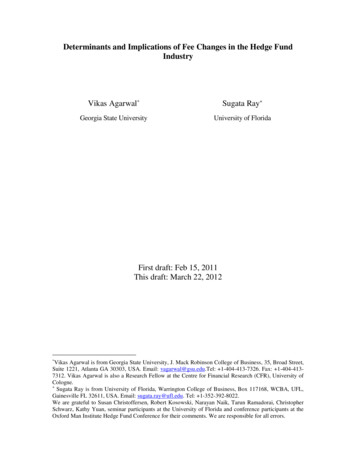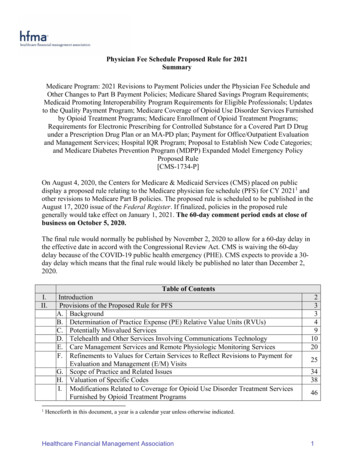
Transcription
Physician Fee Schedule Proposed Rule for 2021SummaryMedicare Program: 2021 Revisions to Payment Policies under the Physician Fee Schedule andOther Changes to Part B Payment Policies; Medicare Shared Savings Program Requirements;Medicaid Promoting Interoperability Program Requirements for Eligible Professionals; Updatesto the Quality Payment Program; Medicare Coverage of Opioid Use Disorder Services Furnishedby Opioid Treatment Programs; Medicare Enrollment of Opioid Treatment Programs;Requirements for Electronic Prescribing for Controlled Substance for a Covered Part D Drugunder a Prescription Drug Plan or an MA-PD plan; Payment for Office/Outpatient Evaluationand Management Services; Hospital IQR Program; Proposal to Establish New Code Categories;and Medicare Diabetes Prevention Program (MDPP) Expanded Model Emergency PolicyProposed Rule[CMS-1734-P]On August 4, 2020, the Centers for Medicare & Medicaid Services (CMS) placed on publicdisplay a proposed rule relating to the Medicare physician fee schedule (PFS) for CY 20211 andother revisions to Medicare Part B policies. The proposed rule is scheduled to be published in theAugust 17, 2020 issue of the Federal Register. If finalized, policies in the proposed rulegenerally would take effect on January 1, 2021. The 60-day comment period ends at close ofbusiness on October 5, 2020.The final rule would normally be published by November 2, 2020 to allow for a 60-day delay inthe effective date in accord with the Congressional Review Act. CMS is waiving the 60-daydelay because of the COVID-19 public health emergency (PHE). CMS expects to provide a 30day delay which means that the final rule would likely be published no later than December 2,2020.I.II.1Table of ContentsIntroductionProvisions of the Proposed Rule for PFSA. BackgroundB. Determination of Practice Expense (PE) Relative Value Units (RVUs)C. Potentially Misvalued ServicesD. Telehealth and Other Services Involving Communications TechnologyE. Care Management Services and Remote Physiologic Monitoring ServicesF. Refinements to Values for Certain Services to Reflect Revisions to Payment forEvaluation and Management (E/M) VisitsG. Scope of Practice and Related IssuesH. Valuation of Specific CodesI. Modifications Related to Coverage for Opioid Use Disorder Treatment ServicesFurnished by Opioid Treatment Programs23349102025343846Henceforth in this document, a year is a calendar year unless otherwise indicated.Healthcare Financial Management Association1
III.IV.V.VI.Other ProvisionsA. Clinical Laboratory Fee Schedule (CLFS): Revised Data Reporting and Phase-inof Payment ReductionsB. Opioid Treatment Program Provider Enrollment Regulation UpdatesC. Payment for Principal Care Management Services in Rural Health Centers(RHCs) and Federally Qualified Health Centers (FQHCs)D. Changes to the Federally Qualified Health Center Prospective Payment SystemE. Comprehensive Screenings for Seniors for Substance Use DisordersF. Medicaid Promoting Interoperability Program RequirementsG. Medicare Shared Savings ProgramH. Notification of Infusion Therapy OptionsI. Modifications to Quality Reporting Requirements on the Extreme andUncontrollable Circumstances Policy for Performance Year 2020J. Proposal to Remove Selected National Coverage DeterminationsK. Requirement for Electronic Prescribing for a Controlled Substance for a CoveredPart D Drug under a Prescription Drug Plan of an MA-PD planL. Medicare Part B Drug Payment for Drugs Approved Through the PathwayEstablished Under Section 505(b)(2) of the Food, Drug, and Cosmetic ActM. Updates to the Certified Electronic Health Record TechnologyN. Proposal to Establish New Code CategoriesO. Medicare Diabetes Prevention Program Expanded Model Emergency PolicyUpdates to the Quality Payment ProgramA. Introduction and BackgroundB. Summary of the Major Proposals for Quality Payment Program Year 5C. Merit-based Incentive Payment System (MIPS) Structural ChangesD. MIPS Performance Category Reporting and Scoring UpdatesE. MIPS Final Scoring Methodology and Payments AdjustmentsF. Third Party IntermediariesG. Physician CompareH. APM Incentive PaymentsPlanned 30-day Delayed Effective Date for the Final RuleRegulatory Impact AnalysisA. RVU ImpactsB. Impacts of Other ProposalsC. Changes Due to the Quality Payment ProgramD. Impact on BeneficiariesE. Estimating Regulatory 109115115119120120124124127127I. IntroductionThe proposed rule would update the PFS payment policies that apply to services furnished in allsites by physicians and other practitioners. In addition to physicians, the PFS is used to pay avariety of practitioners and entities including nurse practitioners, physician assistants, physicaltherapists, radiation therapy centers, and independent diagnostic testing facilities (IDTFs). TheHealthcare Financial Management Association2
proposed rule includes proposals for refining the E/M coding and documentation policiesfinalized in 2020 for implementation January 1, 2021 including proposals to revalue code setsthat rely upon are analogous to office/outpatient evaluation and management (E/M) visitscommensurate with the increases in values for office/outpatient E/M visits for 2021. CMScontinues to make proposals to expand the use of care management services and remotephysiologic monitoring services. The rule also contains proposals designed to address theexpansion of telehealth services covered during the COVID-19 PHE.To promote stability during the COVID-19 PHE, CMS limits the number of proposals in 2021for the Quality Payment Program (QPP). CMS continues to develop the MIPS Value Pathways(MVPs) but defers proposing an initial set of MVPs and policies for their implementation. CMSproposes eliminating the Alternate Payment Model (APM) scoring standard and establishing theAPM Performance Pathway (APP).The proposed conversion factor for 2021 is 32.2605, which reflects a 0.00 percent updateadjustment factor and a budget neutrality adjustment of -10.61 percent (2020 conversion factorof 36.0896*1.000*0.8939). This unusually large budget neutrality adjustment results from therevaluation of the E/M codes and proposed revalue of certain codes analogous to E/M codes.This budget neutrality adjustment reflects the fact that office/outpatient E/M visits areapproximately 20 percent of the PFS allowed charges.Specialty-specific payments impacts vary based on the use and mix of E/M services. Specialtieswhere E/M services represent a greater share of total allowed charges, such as endocrinology( 17%), rheumatology ( 16%), hematology/oncology ( 14%), and family practice ( 13%)would receive the largest increases. In contrast, specialties that have a low use of E/M servicessuch as radiology (-11%), nurse anesthetists (-11%), chiropractor (-10%), pathology (-9%) andphysical/occupational therapy (-9%) would receive the largest decrease.II. Provisions of the Proposed Rule for PFSA. BackgroundSince January 1, 1992, Medicare has paid for physician services under section 1848 of the Act,“Payment for Physicians’ Services.” The PFS relies on national relative values that areestablished for work, practice expense (PE), and malpractice (MP) for each service. Theserelative values are adjusted for geographic cost variations, as measured by geographic practicecost indices (GPCIs). The summation of these relative values or relative value units (RVUs) aremultiplied by a conversion factor (CF) to convert them into a payment rate. This backgroundsection discusses the historical development of work, practice expense, and malpractice RVUs,and how the geographic adjustment and conversion factor are used to determine payment. Thebasic formula is the following:Payment [(RVU work x GPCI work) (RVU PE x GPCI PE) (RVU MP x GPCI MP)] x CFHealthcare Financial Management Association3
B. Determinations of Practice Expense (PE) Relative Value Units (RVUs)1. Practice Expense MethodologyCMS summarizes the history of the development of PE RVUs, the steps involved in calculatingdirect and indirect cost PE RVUs, and other related matters.For 2021, CMS makes note of several issues in this section.Stakeholders have raised concerns about the specialty crosswalk used for home ProthrombinTime (PT)/ International Normalized Ratio (INR) monitoring services used by physicians todetermine the time it takes for a person’s blood plasma to clot. These services are currentlyclassified under the independent diagnostic testing facilities (IDTF) specialty for PE/HRpurposes, but stakeholder do not believe this adequately reflect the indirect costs associated withfurnishing these services. CMS seeks comments regarding the most accurate specialtycrosswalk to use for indirect PE when it comes to home PT/INR monitoring services. It alsowelcomes information on any additional costs associated with these services not currentlyreflected in its assigned crosswalk.With respect to the formula for calculating equipment cost per minute, CMS proposes to treatequipment life durations of less than 1 year as having a duration of 1 year for the purpose of itsequipment price per minute formula. In rare situations where items are replaced every fewmonths, CMS believes it is more accurate to treat these items as disposable supplies with afractional supply quantity as opposed to equipment items with very short equipment lifedurations. This issue arose because the RUC, specialty societies, and other commenterssuggested a useful life of less than 1 year for several of the new equipment items for 2021 and aslow as three months in one case. CMS notes that only 4 out of its 777 equipment codes have auseful life duration of less than 3 years. Moreover, the equipment formula was designed underthe assumption that each equipment item would remain in use for a period of several years and isnot designed for use when equipment is being replaced multiple times per year.2 CMS seekssuggestions on alternative ways to incorporate these items into its methodology or potentialchanges to the equipment cost per minute formula more broadly.CMS also recognizes that that the annual maintenance factor used in the equipment calculationmay not be precisely 5 percent for all equipment. In the absence of an auditable, robust datasource, CMS does not believe it has sufficient information to propose a variable maintenancefactor, though it continues to investigate ways of capturing such information.For example, decreasing the useful life of any equipment item from 5 years to 3 months has the same effect asincreasing the price of the equipment 20 times over.2Healthcare Financial Management Association4
2. Changes to Direct PE Inputs for Specific Servicesa. Standardization of Clinical Labor TasksCMS states that it continues to work on revisions to the direct PE input database to provide thenumber of clinical labor minutes assigned for each task for every code in the database instead ofonly including the number of clinical labor minutes for the pre-service, service, and post-serviceperiods for each code. CMS believes this will increase the transparency of the information usedto set PE RVUs, facilitate the identification of exceptions to the usual values, provide greaterconsistency among codes that share the same clinical labor tasks, and improve relativity ofvalues among codes. In addition, CMS notes the advantage that as medical practice andtechnologies change over time, changes in the standards could be updated at once for all codeswith the applicable clinical labor tasks, instead of waiting for individual codes to be reviewed.CMS notes, as in previous years, that it will continue to display two versions of the Labor TaskDetail public use file to facilitate rulemaking for 2021: one version with the old listing of clinicallabor tasks, and one with the same tasks cross-walked to the new listing of clinical labor activitycodes. These lists are available on the CMS website at -Notices.html.b. Equipment Recommendations for Scope SystemsCMS states that during its routine reviews of direct PE input recommendations, it has regularlyfound unexplained inconsistencies involving the use of scopes and the video systems associatedwith them. It has been exploring this issue since 2017 and has repeatedly expressed its desire tostandardize the description of scopes and its pricing. In 2019, CMS delayed proposals for anyfurther changes to scope equipment until 2020, so that it could incorporate feedback from aRUC Scope Equipment Reorganization Workgroup. In 2020, incorporating this feedback, CMSfinalized its proposal to establish 23 different types of scope equipment (these are listed inTable 5 in the proposed rule). There are seven scope equipment codes that continue to lackinvoices and pricing.For 2021, CMS did not receive any further recommendations from the RUC Scope EquipmentReorganization Workgroup. CMS did receive invoices associated with the pricing of the scopevideo system (monitor, processor, digital capture, cart, printer, LED light) ES031 equipmentitem as part of its review of the Esophagogastroduodenoscopy with Biopsy and the Colonoscopycode families. CMS proposes based on submission of invoices to update the price of the ES031scope video system equipment to 70,673 from 36,306. The total price of 70,673 is based onthe sum of component prices of 21,988.89 for the processor, 16,175.87 for the digital capturedevice, 6,987.56 for the monitor, 7,922.80 for the printer, 4,945.45 for the cart, and 12,652.82 for the LED light. CMS proposes to update this pricing increase over the remainingtwo years of the market-based supply and equipment pricing transition: for 2021 the equipmentprice will be 53,490 before moving to its destination price of the 70,673 in 2022.Healthcare Financial Management Association5
CMS states it remains open to further comments regarding the pricing of the seven scopeequipment codes that lack invoices, as well as additional data regarding the pricing of thescope equipment codes that currently share the same price.c. Technical Corrections to Direct PE Input Database and Supporting FilesFor 2021, CMS proposes to correct an inconsistency in the direct PE input database. CMSproposes to update the global period for CPT code 0446T (Insertion of chest wall respiratorysensor electrode or electrode array, including connection to pulse generator) to add-on status(ZZZ) to more accurately reflect the way in which this service is performed.d. Updates to Prices for Existing Direct PE InputsFor 2021, CMS proposes to update the prices of one supply and four equipment items inresponse to public submission of invoices. Because these pricing updates were each part of theformal review for a code family, CMS proposes that the new pricing take effect for 2021 insteadof being phased in. See Table 27 in the proposed rule for details on the updated prices, CPTcodes affected, and number of services impacted.CMS notes that to be included in a given year’s proposed rule, it generally needs to receiveinvoices by February (February 10th deadline in 2021). CMS notes it will, of course, considerinvoices submitted during the comment period following the publication of the proposed rule orduring other times as part of its annual process.For 2021, CMS also discusses four additional issues: (1) market-based supply and equipmentpricing update, (2) updated supply pricing for venous and arterial stenting services, (3)myocardial PET equipment inputs, and (4) adjustment to allocation of indirect PE for someoffice-based services (fourth and final year of the adjustment)(1) Market-Based Supply and Equipment Pricing UpdateIn 2019, CMS initiated a market research contract with StrategyGen to conduct an in-depthand robust market research study to update the PFS direct PE inputs for supply andequipment pricing.3 These supply and equipment inputs had not been systematicallyexamined since 2004-2005. StrategyGen submitted a report with updated pricingrecommendations for approximately 1,300 supplies and 750 equipment items currentlyused as direct PE inputs. CMS finalized these pricing recommendations with changes toabout 70 supply and equipment codes based on comments and feedback.Given the potentially significant changes in payment that would occur, both for specific servicesand more broadly at the specialty level, CMS finalized a policy to phase in its use of the newdirect PE input pricing over a 4-year period. CMS implemented this pricing transition such thatCMS used its authority under section 1848(c)(2)(M) of the Act, as added by the Protecting Access to Medicare Actof 2014 (PAMA) that allows the Secretary to collect or obtain information from any eligible professional or anyother source on the resources directly or indirectly related to furnishing services for which payment is made underthe PFS.3Healthcare Financial Management Association6
one quarter of the difference between the current price and the fully phased in price isimplemented for 2019, one third of the difference between the 2019 price and the final price isimplemented for 2020, and one half of the difference between the 2020 price and the final priceis implemented for 2021, with the new direct PE prices fully implemented for 2022. Anexample of the transition from the current to the fully implemented new pricing is provided inTable 6 in this rule (reproduced below).Table 6: Example of Direct PE Pricing TransitionCurrent Price 100Final Price 200Year 1 (2019) Price 1251/4 difference between 100 and 200Year 2 (2020) Price 1501/3 difference between 125 and 200Year 3 (2021) Price 1751/2 difference between 150 and 200Final (2022) Price 200CMS highlights two instances where it will continue to fully implement prices with no transition.This includes (1) new supply and equipment codes for which it establishes prices during thetransition years (2019, 2020 and 2021) based on the public submission of invoices, and (2)existing supply and equipment codes, when it establishes prices based on invoices that weresubmitted as part of a revaluation or comprehensive review of a code or code familyCMS highlights two other instances where it proposes to phase-in any new or updated pricingover the remaining years of the proposed 4-year transition period. This includes (1) existingsupply and equipment codes that are not part of a comprehensive review and valuation of a codefamily and for which its establishes prices based on invoices submitted by the public, and (2)any updated pricing on very commonly used supplies and equipment that are included in 100 ormore codes, such as sterile gloves (SB024) or exam tables (EF023), even if invoices areprovided as part of the formal review of a code family. CMS notes that it continues to welcomefeedback from stakeholders, including the submission of additional invoices for consideration.For 2021, CMS received invoice submissions for about a dozen supply and equipment codesfrom stakeholders as part of the third year of the market-based supply and equipment pricingupdate. Based on the review of the invoices, CMS proposes to update the prices of the supplyand equipment items listed in Table 7 in the proposed rule. In those cases, CMS averages theprices from the previous market research and the newly submitted invoices. CMS chose not toupdate the price of certain supply and equipment items for which invoices were submitted as itreceived a single invoice for each item and the invoice prices were significantly higher thanthose reviewed by StrategyGen just two years prior – this included supplies commonly used incytopathology procedures.The full list of updated supply and equipment pricing as it will be implemented over the 4-yeartransition period is available on the CMS website: ate.zipHealthcare Financial Management Association7
(2) Updated Supply Pricing for Venous and Arterial Stenting ServicesStakeholders contacted CMS and presented additional information regarding supply pricingfor certain venous and arterial stenting services. Based on this feedback, CMS proposes toremove the SA103 supply item from CPT codes 37238 (Open/perq place stent same) and37239 (Open/perq place stent ea add) and replace it with a newly created “venous stentsystem” (SD340) at the same supply quantity. CMS proposes a price of 1,750 for thissystem based on the median price of the ten invoices supplied – it chose to use the medianrather than the mean value based on several “outlier” invoices.(3) Myocardial PET Equipment InputsCMS also received additional information regarding the direct PE inputs for several codesassociated with Myocardial PET services. Based on this new information, CMS proposes toupdate the price for the nuclide rod source set (ER044) equipment to 2,081.17 and add theER044 equipment to CPT codes 78432, 78459, 78491, and 78492 (had been inadvertentlyexcluded from the direct PE recommendations) and assigning the same equipment timeutilized by the “PET Refurbished Imaging Cardiac Configuration” (ER110) equipment ineach service. It also proposes to update the useful life of the ER044 equipment to one yearfrom the current useful life of 5 years. CMS notes that these codes are contractor-pricedand thus there will be no change in the national pricing of these codes.(4) Adjustment to Allocation of Indirect PE for Some Office-Based ServicesAs background, CMS allocates indirect costs for each code based on the direct costs specificallyassociated with a code and the greater of either the clinical labor costs or the work RVUs.Indirect expenses include administrative labor, office expense, and all other expenses. For mostservices, the direct PE input costs are higher in the nonfacility setting than in the facility setting,and thus indirect PE RVUs allocated to these services are higher in the nonfacility setting than inthe facility setting. In cases where direct PE inputs for a service are very low, however, theallocation of indirect PE RVUs is almost exclusively based on work RVUs, which results in avery small (or no) site of service differential between the total PE RVUs in the facility andnonfacility setting. In 2018, CMS finalized a modification in the PE methodology for allocatingindirect PE RVUs to better reflect the relative indirect PE resources involved in furnishing theseservices (mostly behavioral health services). CMS refers readers to the 2018 PFS final rule (FR52999 through 53000) for a discussion of this revised methodology. CMS first beganimplementing this modification in 2018, the first year of a 4-year transition.For 2021, CMS proposes to continue with the fourth and final year of the transition of thisadjustment to the standard process for allocating indirect PE. There are 30 codes affected by thispolicy, and the list is available on CMS’ website.4See ectpe.zip4Healthcare Financial Management Association8
e. Update to Technical Expert Panel Related to Practice ExpenseCMS provides an update on the RAND Corporation’s efforts on studying potentialimprovements to CMS’ PE allocation methodology and the supporting data. The current systemfor setting PE values relies in part on data collected in the Physician Practice Information Survey(PPIS) which was administered by the AMA in 2007 and 2008.In its first phase of its research, RAND concluded that the PPIS data are outdated (e.g., precededthe widespread adoption of electronic health records) and may no longer reflect the resourceallocation, staffing arrangements, and cost structures that describe practitioners’ resourcerequirements in furnishing services to Medicare beneficiaries.5 RAND found, for example, thataggregating Medicare provider specialties into broader categories resulted in small specialtylevel impacts relative to the current system suggesting that specialty-specific inputs may not berequired.To follow-up on some of these issues, RAND convened a technical expert panel (TEP) onJanuary 10, 2020 to obtain input from stakeholders and is available athttps://www.rand.org/pubs/working papers/WR1334.html. Topics included, for example, howbest to aggregate PE categories if there were to be new survey instrument; ways to maximizeresponse rate in a potential new survey; and using existing data to inform PFS PE rates. RANDalso issued results from its subsequent phase of research.6Based on the results of the TEP and RAND’s other ongoing research, CMS states that it isinterested in potentially refining the PE methodology and updating the data used to makepayments under the PFS. CMS states hat stakeholders have expressed an interest in updating theclinical labor data used for direct PE inputs based on current salaries and compensation for thehealth care workforce. It currently uses data from the Bureau of Labor Statistics (BLS). CMSsolicits comments regarding on how it might update the clinical labor data and whetherBLS data is the best data source or if there is an alternative.CMS also indicates an interest in hosting a Town Hall meeting at a date to be determined toprovide an open forum for discussion with stakeholders on its ongoing research to potentiallyupdate the PE methodology and the underlying inputs. CMS indicates it is not makingproposals based on this report at this time but seeks feedback regarding RAND’s report.Comments can be submitted as public comments or, if outside the public comment process,via email at PE Price Input Update@cms.hhs.gov.C. Potentially Misvalued Services under the PFSCY 2021 Identification and Review of Potentially Misvalued ServicesCMS received multiple submissions nominating CPT code 22867 as a potentially misvaluedservice. CPT code 22867 describes the insertion of a “interlaminar/interspinous process56See https://www.rand.org/pubs/research reports/RR2166.htmlSee https://www.rand.org/pubs/research reports/RR3248.html.Healthcare Financial Management Association9
stabilization/distraction device, without fusion, including image guidance when performed, withopen decompression, lumbar; single level.” Commenters suggested that the physician work forthis code is significantly undervalued when compared to CPT code 63047 (“Laminectomy,facetectomy, and foraminotomy, single vertebral segment; lumbar”). Commenters were alsoconcerned that the malpractice RVUs were not aligned with similar spine proceduresCMS proposes to nominate CPT code 22867 as a potentially misvalued code.D. Telehealth and Other Services Involving Communications Technology1. Payment for Medicare Telehealth Services Under Section 1834(m) of the ActIn the 2003 PFS final rule (67 FR 79988), CMS established a process for adding or deletingservices from the Medicare telehealth list. CMS assigns requests to two categories: Category 1and Category 2. Category 1 services are similar to services that are currently on the telehealthlist. Category 2 services are not similar to services on the telehealth list, and CMS requiresevidence demonstrating the service furnished by telehealth improves the diagnosis or treatmentof an illness or injury or improves the functioning of a malformed body part. For 2021, requestsmust have been received by February 10, 2020.The Medicare telehealth services list is available on the CMS website formation/Telehealth/index.html.Information about submitting a request to add services to the Medicare telehealth services list isalso available on this website.a. Requests to Add Services to the Medicare Telehealth Services List for 2021In response to the public health emergency (PHE) for COVID-19, CMS undertook emergencyrulemaking to add a number of services to the telehealth list on an interim basis.7 The tablebelow list the additional services CMS finalized to the telehealth list on a Category 2 basis forthe duration of the PHE.Service TypeEmergency Department VisitsInitial and Subsequent Observation and Observation Discharge DayManagementInitial hospital care and hospital discharge day managementInitial nursing facility visits and nursing facility discharge day managementCritical Care ServicesDomiciliary, Rest Home or Custodial Care servicesHome VisitsInpatient Neonatal and Pediatric Critical CareInitial and Continuing Intensive Care ServicesAssessment and Care Planning for Patients with Cognitive ImpairmentGroup PsychotherapyCPT codes99281-9928599217-99220; 99224-99226;99234-9923699221-99223; 99238-9923999304-99306; 99315-9931699291-9929299327-99328; 99334-9933799341-99345; 99347-9935099468-99472; 99475-9947699468-99473; 00475-994769948390853Medicare and Medicaid Programs; Policy and Regulatory Revisions in Response to the COVID-19 Public HealthEmergency” interim final rule with comment period (IFC), referred to as the March 31st COVID-19 IFC.7Healthcare Financial Management Association10
Service TypeEnd-Stage Renal Disease (ESRD) ServicesPsychological and Neuropsychological TestingTherapy Services, Physical and Occupational TherapyRadiation Treatment Management ServicesCPT codes90952, 90953, 90959, and9096296130-96133; 96136-9613997161-97168; 07110, 97112,97116, 97537, 97750, 97755,97760, 97761, 92521-92524,9250777427CMS considered which services added to the telehealth services list on an interim basis shouldremain on the telehealth service list after the end of the PHE. The table below (based on Table 8in the proposed rule) lists the services CMS proposes to add to the Medicare telehealth servicelist on a Category 1 basis. CMS believes these services are similar to services currently on thetelehealth services list.2021 Proposed Additions to the Medicare Telehealth Services List on a Category BasisHCPCS CodeCode DescriptionGPC1XVisit complexity inherent to E/M (Add-on code)9085
B. Summary of the Major Proposals for Quality Payment Program Year 5 84 C. Merit-based Incentive Payment System (MIPS) Structural Changes 85 D. MIPS Performance Category Reporting and Scoring Updates 91 E. MIPS Final Scoring Methodology and Payments Adjustments 101 F. Third Party Intermediaries 109 G. Physician Compare 115
